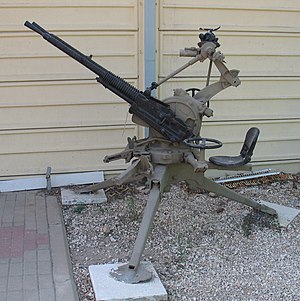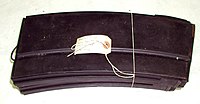Hotchkiss M1929 machine gun
| Hotchkiss model 1930 | |
|---|---|
 A mitrailleuse de 13.2 mm CA mle 1930, in Batey ha-Osef Museum, Tel Aviv, Israel. | |
| Type | Heavy machine gun |
| Place of origin | France |
| Service history | |
| Used by | See Users |
| Wars | World War II |
| Production history | |
| Designed | 1929 |
| Manufacturer | Hotchkiss et Cie |
| Specifications | |
| Mass | 37.5 kg (83 lbs) single gun, stripped |
| Length | 1.67 m (5 ft 6 in) |
| Barrel length | 1 m (3 ft 3 in) |
| Shell | 13.2 x 96 mm |
| Caliber | 13.2 mm |
| Action | Gas operated |
| Elevation | -10° to +90° |
| Traverse | 360° |
| Rate of fire | 450 rpm (cyclic) 200-250 rpm (sustained) |
| Muzzle velocity | 800 m/s (2,625 ft/s) |
| Effective firing range | 4,200 m (13,800 ft) AA ceiling |
| Maximum firing range | 7.2 km (4.5 mi) at 45°[1] |
| Feed system | 30-round box magazine, or 15-round feed strip |
The 13.2 mm Hotchkiss machine gun was a heavy machine gun designed and manufactured by Hotchkiss et Cie from the late 1920s until World War II and saw service with various nations' forces, including Italy and Japan where the gun was built under license.[2]
Development[]
In the late 1920s, Hotchkiss proposed a range of anti-aircraft automatic weapons in the 13.2, 25 and 37 mm calibers. They were all based on the same type of gas-operated action. The 8 mm mle 1914 machine gun had proven extremely reliable during World War I and was still in service. The gun started with a 13.2 x 99 cartridge but in 1935 changed over to a 13.2 x 96 cartridge.[3] The majority of guns were fed from overhead 30 round curved box magazines. The guns had a cyclic rate of fire of 450 rounds per minute but their sustained rate of fire was 200-250 rounds per minute due to the need to change magazines which limited their rate of fire. The guns came in a number of different configurations depending on their intended role.
There were single, double and quadruple barreled anti-aircraft weapons on a high-angle pedestal and tripod mounts as well as low-angle bi-pod mounts for anti-tank and heavy machine gun roles. French infantry commanders that had expressed interest in acquiring light anti-aircraft guns refused to accept the 13.2 mm. They argued that those heavy bullets falling down could be dangerous to friendly troops, and went to larger calibers where self-destructing shells were available. But the 13.2 mm Hotchkiss saw extensive use as a naval gun and was also chosen by the French cavalry for some of its armored vehicles.
Service[]
As a ground-based anti-aircraft weapon[]
The French Air Force used designated as mitrailleuse de 13.2 mm CA mle 1930, for close-range defense of its airfields and other strategic places.
It came in two versions:
- The first was a single gun with a stock and pistol grip that came in a dual-purpose anti-aircraft/anti-armor mounting. It had a two-wheeled split-trailed carriage that weighed 117 kg (259 lb) empty and 155 kg (342 lb) with the machine-gun mounted. When the swing-arm the gun was affixed to was locked upwards, it could be used in an anti-aircraft mode. When the arm was collapsed and a bipod extended it could fire straight ahead in an anti-tank role. When the gun was packed up and the trails closed, it was towed behind its caisson, which was pulled by a horse or by the gunner.
- Second was a fixed tripod mount with a seat and anti-aircraft sight for the gunner. It came in a single mount 120 kg (270 lb) empty, 160 kg (352 lb) mounted. Or a double mount 225 kg (496 lb) empty, 300 kg (662 lb) mounted.
[]
Early in World War II, the French, Italian and Japanese navies were using twin (CAD Mle 1929 - Contre Avions Double) and quadruple (CAQ mle 1929 - Contre Avions Quadruple) mountings on many of their warships. French warships that were refitted in the United States in 1943, such as the battleship Richelieu or the destroyer Le Terrible, had their 13.2 mm machine guns replaced by more powerful Oerlikon 20 mm cannons.
In Italy, the Società Italiana Ernesto Breda produced the gun under license as the Breda Mod.31 from 1931 onwards. It was used as an anti-aircraft gun aboard ships, submarines, and armored trains Royal Italian Navy. After World War II it was used on the patrol boats of the Guardia di Finanza naval service.
The Spanish Navy bought this weapon in December 1935 and used it during the Civil War (where it was mounted on several Republican Navy destroyers and cruisers). The "Pirotecnia Militar" Army Ammunition plant (Sevilla) produced its cartridges after 1939.
As a ground weapon[]
Several self-propelled anti-aircraft combinations were tested in the 1930s, with Citroën-Kegresse or Berliet chassis, but none was mass-manufactured. The 13.2 mm Hotchkiss was used on the Belgian T15 (a combat vehicle) and the French AMR 35, light tanks as well as the White-Laffly AMD 80 armoured car and on fortifications. The Free French used field-modified self-propelled mountings, with guns recovered from French ships, in North-East Africa in 1942. The Breda Mod.31 was used as an anti-aircraft and heavy machine gun on command tanks of the Royal Italian Army as well as on L3/33 light tanks sold to Brazil. The Japanese mounted license-produced version of the gun on a number of Type 92 Heavy armored Cars which had initially been armed with only a pair of 6.5mm machine guns.
Users[]
This article needs additional citations for verification. (May 2020) |
 Belgium
Belgium Brazil
Brazil France
France Nazi Germany - Captured French guns were designated MG 271(f).
Nazi Germany - Captured French guns were designated MG 271(f). Greece
Greece Israel
Israel Italy - Built under license as the Breda Model 1931 machine gun.
Italy - Built under license as the Breda Model 1931 machine gun. Japan - Built under license as the .[4]
Japan - Built under license as the .[4] Poland - Designated the wz.30.
Poland - Designated the wz.30. Republic of China
Republic of China Romania - 200 delivered before the Fall of France[5] and delivered by Germans from captured material[citation needed]
Romania - 200 delivered before the Fall of France[5] and delivered by Germans from captured material[citation needed] Spain
Spain Kingdom of Yugoslavia
Kingdom of Yugoslavia
See also[]
- Anti-aircraft
- 25 mm Hotchkiss anti-aircraft gun - A closely related French anti-aircraft gun.
- Type 96 25 mm AT/AA Gun - A closely related Japanese anti-aircraft gun.
Gallery[]
Three different 13.2 mm cartridges: M29 Hotchkiss Long 13.2x99mm, M35 Hotchkiss Short 132x96mm, and Mauser 13.2x92mm TuF.

A Japanese 30 round box magazine.

A quadruple naval mounting, as illustrated in US Patent 1700902 filed by Yves Le Prieur.

A dual gun pedestal mount of the Free French Navy.

A wz.30 dual gun pedestal mount used on the Polish submarine ORP Żbik.

The related Japanese Type 93 single mount.

The related Japanese Type 93 double mount.

Yiftach Brigade with their Hotchkiss machine guns during the battle for Safed, 1948.
References[]
- ^ "France 13.2 mm (0.5") Model 1929 - NavWeaps". www.navweaps.com. Retrieved 2019-03-30.
- ^ "Modern Firearms".
- ^ "13,2x96 Hotchkis Short / MUNICION.ORG". www.municion.org. Retrieved 2019-03-30.
- ^ Lai, Benjamin (29 Jun 2017). Shanghai and Nanjing 1937: Massacre on the Yangtze. Campaign 309. Osprey Publishing. p. 26. ISBN 9781472817495.
- ^ Mark Axworthy, London: Arms and Armour, 1995, Third Axis, Fourth Ally: Romanian Armed Forces in the European War, 1941–1945, p. 29
Bibliography[]
- Campbell, John (1985). Naval Weapons of World War Two. Annapolis, Maryland: Naval Institute Press. ISBN 0-87021-459-4.
Further reading[]
| Wikimedia Commons has media related to Hotchkiss Model 1930. |
- Ferrard, Stéphane. France 1940 l'armement terrestre, ETAI, 1998, ISBN 978-2-7268-8380-8
- "Las armas de la guerra civil española", José MAría MANRIQUE, ISBN 84-9734-475-8, pages 394 -398
- World War II anti-aircraft guns
- World War II weapons of France
- Machine guns of France
- Heavy machine guns
- World War II machine guns
- Hotchkiss et Cie
- World War II weapons of Greece
- Military equipment introduced in the 1920s








